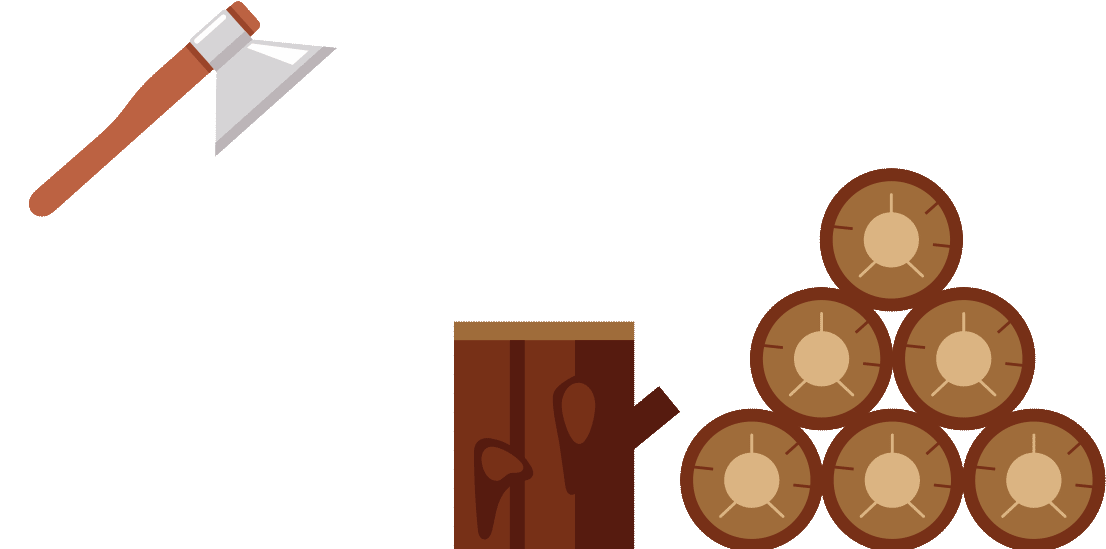
Most mythologies hold the idea of an 'original forest'. A supposed "primary", "virgin" and "wild" forest that would have preceded mankind.
Carbon 14 dating, electronic paramagnetic resonance and dendrochronology challenge the myth of a forest-covered Earth.

Apes' and Humans' common ancestor might have lived in trees, but we don't really have footage of it climbing down from one. An ancestor we do know about, the Cro-Magnon man, lived in areas of steppe and tundra populated by bison, aurochs and reindeer, where there were no trees. He experienced the last ice age, which ended 14,000 to 10,000 years before our era.




The Chauvet Cave's walls bear the oldest cave paintings in France (36,000 B.C.): bears, mammoths, woolly rhinoceroses, aurochs, reindeer, felines, horses, bison and megaceros are represented there. These animal species did not live in forests, but in vast open plains. It is assumed that the megaceros, the largest deer of all time, retreated from the continent as the forests advanced from the south, finding refuge in Ireland and Britain before the ice cap melted. Similarly, because its prey disappeared, the Eurasian cave lion died out about 14,000 years before our era.

As we know, nature abhors a vacuum. Once the ice cap disappeared, plants and later on trees earned their place in the sun. Of course, the process wasn't instantaneous: it took a couple of millennia! This last ice age was followed by a period of global warming, melting glaciers and increasing humidity.
From 8,000 B.C. to 7,000 B.C. lichen and moss were replaced by birch and pine. These are called pioneer species.
From 6,800 B.C. to 5,500 B.C. hazel trees and mixed oak groves' development was favoured by a warmer and drier period.
As of 2500 B.C. the colder and wetter winters allowed species favoring shade and humidity to take root, such as beech and some conifers (spruces, firs, yews).

Click on the trees to find out more!










8 000 B.C. to 7 000 B.C.
From 8,000 B.C. to 7,000 B.C. lichen and moss were replaced by birch and pine. These are called pioneer species.
6 800 B.C. to 5 500 B.C.
From 6,800 B.C. to 5,500 B.C. hazel trees and mixed oak groves' development was favoured by a warmer and drier period.
From 2 500 B.C.
As of 2500 B.C. the colder and wetter winters allowed species favoring shade and humidity to take root, such as beech and some conifers (spruces, firs, yews).
Here we can speak of natural forests, since mankind had little to no involvement in their development. They still lead a nomadic life of hunting, gathering and fishing, although sedentarization was in progress.
There is no scientific definition of a virgin or primary forest, so these concepts must be handled with care. First, it is impossible to say that a forest is completely devoid of human presence. Even the Amazon forest, seemingly the most inextricable of all, is spattered with traces of very ancient civilizations and is the home of native tribes to this day. If we were to define a primary forest as the first of the forests, one installed before any human intervention, then Cro-Magnon man would have encountered primary forests in Europe. However this 'wild' state did not last long.
In other words, western forests have never been truly pristine and hardly ever primary.
Indeed, starting from the Neolithic period (Western Europe: between 6,500 and 4,700 B.C. approximately),
That is to say, as forests spread from southern Europe, human populations cut meadows and fields to establish livestock breeding and agriculture, techniques that slowly came to them from the civilizations of the Fertile Crescent and Mesopotamia.

Once the polished stone axe was developed, it was possible to cut down trees. At the same time, mankind began to prepare the soil before sowing.



Taking advantage of areas with low forest cover, men extended clearings and meadows, areas that they dedicated to cultivation and grazing.

Thus, little by little, native plants are replaced by cultivated or weedy varieties.


Unseeded plant, often considered a weed
Men introduced cereals, goats, sheep and cattle, among other things.
Although sedentarisation was enabled by the mastery of new techniques, it is worth noting that it was also forcibly brought about by the arrival of forests and global warming. Indeed, as large game moved northwards or simply disappeared, hunter-gatherers had to become farmers so as not to die of starvation.

Prior to the final establishment of agriculture and livestock farming, there was no domestication of nature. The poverty of European vegetation is due to climatic changes and mountainous relief. It is by no means man-made.
Did we misunderstand myths, or did modern reinterpretation make them lose their meaning?
Paradoxically, when man lived in vast plains, he did not farm. This was because game was abundant, population was small, and the land was often frozen and unsuitable for growing crops. As trees grew, they shaped and fertilized the landscape, providing shade and conserving water, allowing the perennial settlement of populations, livestock and agriculture. This began in Mesopotamia, the Fertile Crescent and the Caucasus regions, before reaching Europe via Greece, the Balkans and Italy.



The vine is a liana plant, and it is estimated that the first vinification took place in the Caucasus region between Georgia and Armenia. It is in Georgia, by the Black Sea, that the greatest variety of grape varieties has been found. Residues of winemaking have been found in this region, dating back to 6 000 B.C.


Yet the Romans, whose world view and dichotomisation of 'civilization versus barbarism' still lingers to this day , approached things quite differently. Perhaps the original story was lost when they retroactively reshaped History and defined culture as that which is opposed to the forest.








Myths assume an idealized period of harmony between man and his natural environment. They're committed to describing the upheaval that sedentarisation was for mankind, as well as its effect on nature.


They feared divine retaliation. In most myths, we find this feeling of men's guilt towards Mother Nature, which they subject to their ambitions.





The myth of the tree of life or of the World Tree, which is found in many cultures, highlights the ambiguous relationship between humans and their natural environment. The tree is worshipped or revered as a deity that can heal people of their ills, ills often attributed to their actions against nature. If men suffer from illnesses, it is because nature punishes them. And if nature suffers, men suffer too. Archaic myths reveal a very strong and even sacred link between the life of trees and that of men. This proves that Neolithic man was aware of the life he owed to nature, especially to the trees that gave him the opportunity to cultivate the land.

The Romans themselves feared attacking trees, which all ancient peoples divinized in one way or another.

Silva, in Latin, means wild, and it is this root that many languages have relied on to construct the words defining activities relating to the forest: "sylviculture", "sylvester"… Among the Romans, the forest ("silva") is opposed to the "respublica", that is to say 'public affairs', the place of human laws. For them, the woods delineated the edge of the civilized world, one governed by the laws of the Republic.
Civilized man lived in the city and barbarians in the woods. Civilized people are therefore sedentary men who know how to cultivate and transform nature's products. This conceptualisation erased the fact that civilization was made possible by forests' existence. It is understandable that this vision of the world, theorized at the beginning of our era, several thousand years after the beginnings of sedentarisation, would have forgotten the profound causes of this historical change. Myths reveal some things, and hide others.



The Roman Empire set out to develop cities, fields for cultivation and meadows, all at the expense of forests. Some peoples, notably the Gauls, worked wood very well to make tools, furniture, houses, means of transport and weapons, which the Romans would later acquire and perfect.
Wooden products then became fully integrated in ancient societies' economic system.



And yet, contrary to popular belief, in Roman times, Western Europe was not covered with wood.
 Je teste mes connaissances
Je teste mes connaissances  Test my knowledge
Test my knowledge Next chapter
Chapter 1 . Lesson 2